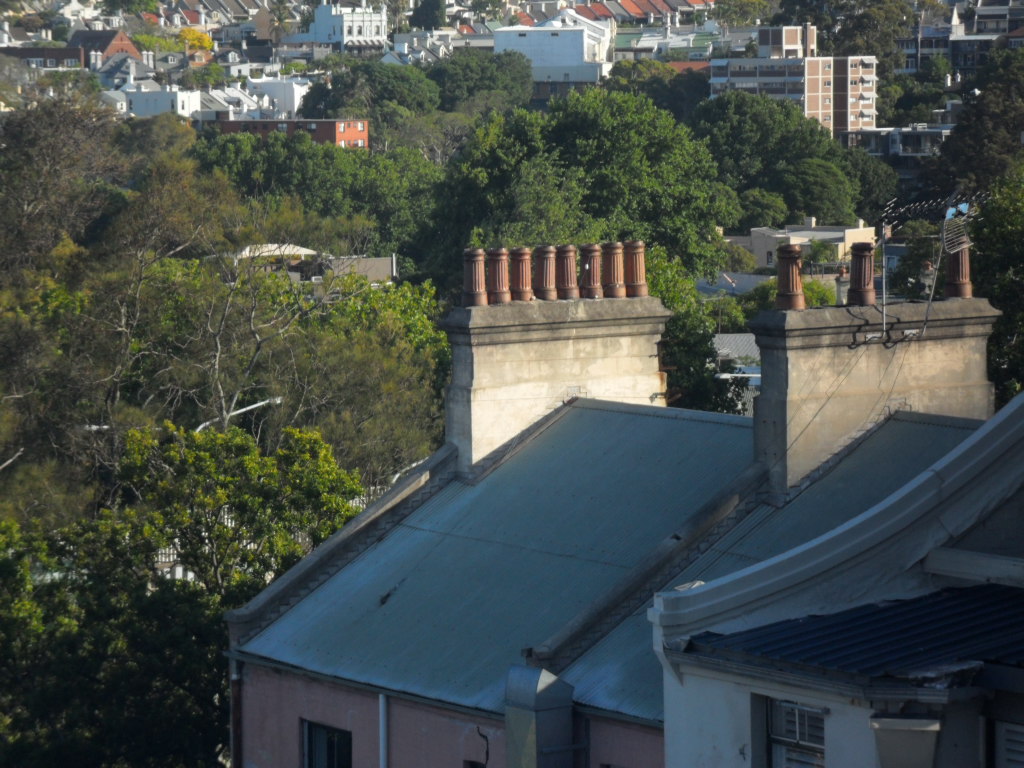Our Historic Chimneys – a clue to the past

The 2011 postcode area contains Australia first suburb, Potts Point, an original independent suburb from the City. In 1834 substantial villas were erected according to government regulations. After the 1850s gold rush a building boom brought with it a rapid expansion of housing including the ubiquitous terrace house. This was a surprisingly sustainable concept even by today’s standards. In many instances the builder built his own home and then a few more adjacent. This can be seen in the groups of terraces dotted around the city and in suburbs like Potts Point and Paddington.
Status was important to owners and their home’s presentation to the street and its facade were crucial.
But for those with a keen eye external details provided an insight into their luxurious interiors. The number of fireplaces provided warmth so the number of chimney pots provided a clue to the interior’s level of comfort, the expense incurred and the owner’s status. So a large of chimney pots on the roof was a sure indication of the status of the owner and the more chimney pots, the higher quality of the interior.
Chimneys were not just decorative. They incorporated rain guards and smoke vents.
An American writer noted In “Cottage Residences (1842)” that “one of the most characteristic and beautiful features in architecture is the ornamental chimney pot, sometimes rising singly, sometimes in clusters from the roof, but frequently wreathed and molded in the most picturesque manner.” Windows and chimney tops he noted, “are two of the most essential and characteristic features of dwelling houses…to which decoration should always be first applied”.
Chimneys have been an important part of buildings for centuries. In the UK they were first found in castles and then in large manor houses.
According to the Oxford English Dictionary, the word chimney originally meant a fireplace, and is thought to be derived from the Latin Caminus, meaning furnace, forge or oven. Later it was called a “chimenee”.
In Sydney the nineteenth century was the golden age for chimney pots.
The photo above shows clumps of terrace house roofs in Bayswater Road, Rushcutters Bay, with their clusters of intact chimney pots.
The purpose of chimney pots was to increase the speed that smoke rises by reducing the size of the outlet: warm air rises so a bottleneck creates a jet-like effect.. This reduction in the size of the opening also reduces the entry of rain and downdrafts of air that can prevent the smoke leaving the building, and scatter hot embers from the fire. . Openings in the pot, like louvres, grills, pockets and horns, promote cross-drafts at the top, which also serve to increase the flow of smoke up the chimney.
They eventually went out of fashion when electrical and central heating came into fashion making labour-intensive log and coal fires redundant
Clay pots came in three main finishes: terracotta red; terracotta buff or a ceramic glaze. The sheer number of different designs means it is not clear how many different types exist. Many were one-off creations but a chimney pot museum in the UK has a collection of over 2,500 different pots.
Chimney pots even had exotic names like Weemac and Spiral Captain, and different manufacturers called the same design by different names such as Smoke Cure and Champion.
The next time you see a nineteenth century building look up. The number of chimney pots indicates the original owner’s status.
By Andrew Woodhouse
Heritage Solutions





